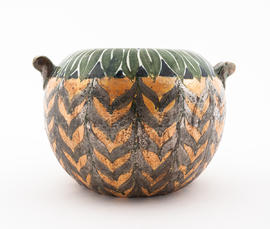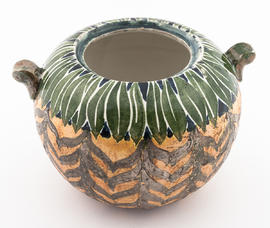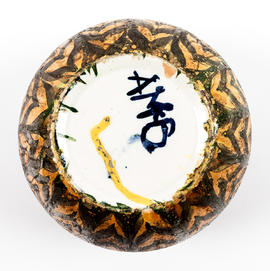Key Information
Reference code
Title
Date(s)
- c1900 (Creation)
Level of description
Item
Extent
1
Content and Structure
Scope and content
Ginger jar without a lid. Handpainted green leaves around the mouth and a yellow design around the body. Two small handles on either side. Signed "AMcB" on the bottom. Ginger jars were initially used to store and transport spices and have been used as decorative items. Similar in shape to a Mary Fairgrieve two-handled pot - possibly a large sugar basin - decorated with a typical Glasgow School design that is featured in the Scottish Pottery 25th Historical Review 2013.
Appraisal, destruction and scheduling
Accruals
System of arrangement
General Information
Name of creator
Biographical history
Ann Macbeth was born in Bolton in 1875, as the eldest of nine children of a Scottish Engineer.[1] She was at the Glasgow School of Art in the capacity of a student from 1897-1909. We know from the student records that are held within the school that her father’s occupation was that of engineer.[2] Her addresses are also listed: she came to Glasgow from St. Anne’s on the Sea, Lancashire, and in Glasgow she lived from 1897-98 at 9 Park Quadrant, 1898-99 as 15, Windsor Circus, Kelvinside, from 1899 as 6 Melrose Street, and from 1905 as Queen Margaret Hall.
Before 1902 her occupation is given in the student registers as either “Art Student” or “Designer”. From the session 1902-3 her occupation is listed as that of “Teacher”, but she still appears in the student registers because she continued to advance her formal education through the attendance of classes at the school.[3] For example, we know from the registers that in 1904-5 she was a day student in the upper course, design, and she took further courses in design up until 1909.[4] In 1902 she was appointed to the position of Assistant Mistress, teaching courses in needlework, embroidery and applique, in the Design and Decorative Art Section.
She continued to teach in the Glasgow School of Art until her retirement in 1929, gaining extra responsibilities until she left. In 1903-5 she taught Design and Instruction, from 1906 taught Metalwork and Repousse, and Bookbinding and Decoration from 1907. In 1909 she became the head of the Needlework and Embroidery Section, adding Bookbinding and Decoration and Decorative Leatherwork to these responsibilities in 1910. In 1911 Macbeth published Educational Needlecraft, a course in needlecraft for use in schools, with fellow GSA teacher Margaret Swanson. The course was tailored for each stage of childhood development, to nurture both creative and technical development as students mature, and sought to promote the artistic merits of embroidery.
In 1912 she finally became the Director of Studies in the Needlecraft-Decorative Art Studios.[5] The same year, Macbeth was briefly held in solitary confinement and subjected for forced feeding as punishment for her suffragist activism. This experience is described in letters Macbeth wrote to GSA administrators; their response shows support for her recovery over five months of absence.
In addition during her time at the Glasgow School of Art Ann Macbeth also taught classes in Ceramic Decoration and China Painting. Even after she moved to the Lake District in the 1920s she held the prestigious position of Visiting Lecturer – Needlework and Embroidery from 1921 until her retirement in 1929.[6]
Related Material: Please note, GSA Library has digitised the following volumes from its collections related to Ann Macbeth:
- Embroidered and Laced Leather Work (1930): https://archive.org/details/embroideredlaced00macb
- School and Fireside Crafts (1930): https://archive.org/details/schoolfiresidecr00macb
- The Country Woman's Rug Book (1932): https://archive.org/details/countrywomansrug00macb
Archival history
Custodial history
Gifted to GSA c1980.
Physical Description and Conditions of Use
Conditions governing access
Conditions governing reproduction
Language of material
Script of material
Language and script notes
Physical Description
Hand-painted ceramic.
Dimensions: 110 x 152 x 152 mm




